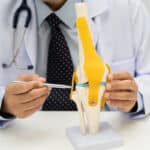
If you play sports, you are likely to deal with a sprained ankle at one point or another. The injury is common, and every day, our team of physiotherapists in the clinic treats patients with sports medicine techniques in OKC. Now, with the experts at the pain clinic, we will look at the injury in detail.
Ankle Sprain and Its Causes
15% to 30% of all sports injuries come from sprains, as per the research. Ligaments help to stabilize the joints and prevent wayward movement. If the foot rolls or turns beyond its regular motions, the result is an ankle sprain. It could occur if the foot is incorrectly planted, the soil is unbalanced, or the joint experiences significant pressure, such as after a jump.
In this case, the ligaments around the ankle can be severely extended and damaged. The damaged ligament causes inflammation in the affected joint in addition to swelling and bruising. Ligament injuries on the outer side of the ankle involve the most sprained ankles.
Common Symptoms of Ankle Sprain
-
Incapability to endure weight on the affected ankle.
-
Pain in the ankle. (It can be mild to severe)
-
Decreased movement of the ankle joint.
-
Inflammation.
-
Bruises.
-
Instability in the ankle.
How You Can Get Help
Diagnosing a sprained ankle usually needs a thorough look from a physiotherapist. Excluding the possibility of fracture, the severity of the sprain should be classified:
Sprain Grade 1: Light sprain and damage to the ligament fibers.
Sprain Grade 2: Partial ligament tearing causing abnormal looseness of the ankle joint.
Sprain Grade 3: Complete ligament tearing with intolerable pain.
The treatment most likely follows the below-mentioned methods:
-
RICE (Rest, Ice, Compression, Elevation)
-
Massaging the soft tissue around the joint
-
Joint mobilization
-
Electrical therapy
-
Range of motion exercises
-
Strength training
-
Gait training
-
Proprioceptive training
-
Taping
-
Advice on Activity modification
-
Return to the activity program
Long-term adverse effects, such as chronic instability, a decreased range of activities, and pain, can occur without proper treatment for an ankle sprain. Studies show that ankle sprain relapses for up to 80% of people, and this is usually due to sub-optimal treatment during the healing process. It is the reason why sports medicine in OKC is so essential.
If your problem is severe, you may undergo extensive treatment. Come to Oklahoma Spine & Pain Management and get the right treatment with an accurate diagnosis.
* * Disclaimer: This content should not be considered medical advice and does not imply a doctor-patient relationship.






